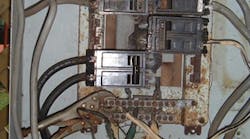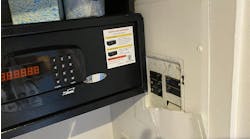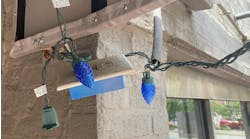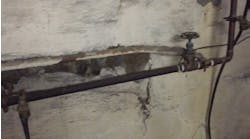As usual, never consider the following commentary associated with these photos as a formal interpretation of the National Electrical Code (NEC). Without criticizing anyone or any product, the following scenarios present us with serious safety questions.
GET A GRIP
Darryl Dempsey, chief electrical inspector, Hillsborough County, Fla., discovered this installation while investigating a complaint lodged by the local power company. At first glance, it's apparent that the severely deteriorated main panel needs to be replaced. The 10 AWG wire's termination on a double-pole, 70A breaker may be a clear violation, but the most alarming part of this installation is the use of vise grip pliers to terminate the neutral. Note how the vise grip rests on top of the conductor. The circuit was operational and served a travel trailer some 200 ft away.
Although this violation isn't specifically noted in the Code, it's covered under the more general requirements of 110.2, which states that conductors and equipment required or permitted by the Code are acceptable only if approved. Its accompanying Fine Print Note directs you to 90.7 Examination of Equipment for Safety and 110.3 Examination, Identification, Installation, and Use of Equipment.
KEEP OUT OF MY SPACE
Russ LeBlanc, an instructor for The Peterson School in Woburn, Mass., discovered this violation of working clearances (Art. 110). The panelboard on the wall had a clear working space before the addition of sprinkler backflow valves. The required working space around electrical equipment is often encroached upon by plumbing pipes, HVAC ducts, and various other obstructions after the initial electrical installation. This sets up a dangerous situation for the electrical worker, who must try to stay safe when performing maintenance or retrofits despite the limited work space.
LeBlanc has submitted a change proposal to the 2005 NEC to address this situation. His proposal calls for field marking the area around electrical equipment to help alert non-electrical workers that this space needs to be kept clear for electrical safety reasons.
SPLICES IN A BOTTLE
Shawn Crawford, engineering technician, Anniston, Ala., found this “splice in a bottle” installation while conducting an above-ceiling inspection on a renovation project at a school in Shelby County, Ala. Crawford later learned the county maintenance department had created this installation while installing a circuit to feed a new piece of electrical equipment. Notice how they rigged up this pseudo junction box to house the new splice by taping it to a steel structural member of the building.
Boxes must be installed in accordance with 300.15. A box must be installed at each outlet and switch point for concealed knob-and-tube wiring. A box or conduit body that complies with Art. 314 must be installed at each conductor splice point, outlet point, switch point, junction point, termination point, or pull point in installations that use conduit, tubing, or AC, MC, MI, nonmetallic-sheathed, or other types of cable, unless otherwise permitted in 300.15(A) through (M).



